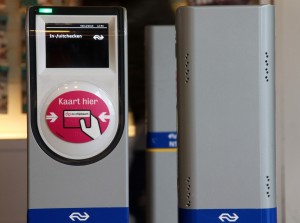Posted in August 2015
The technology used when you borrow books from the library
In my last blog post I briefly described RFID technology. In this blog post I will give one implementation example as seen in the TU Delft library.
The books in the library have a paper thin passive RFID tag attached to the backcover. This tag contains information related to the book, mostly in the form of a unique identification number. When you want to borrow a book, you can use one of the self checkin/checkout stations. You need to place the campus card (if student or employee of TU Delft) or library membership card on the card reader to identify yourself. On placing one or several books on the self checkin station, the RFID tag is read by the reader. Placing multiple books on top of each other should be avoided as the reader may not be able to identify individual books due to tag collision. The reader communicates with a server to inform that one or several books have been checked-in by the identified visitor and this information is stored in the database. When you return (checkout) the books to the library, a similar sequence of events take place. If you require assistance, the librarian at the service desk can help you by using the checkin/checkout station available at the service desk. While leaving the library, you pass through exit sensors (another reader with a longer detection range than checkin/checkout stations) which verifies if the book has been checked-in. If the book has not been checked-in, an alarm is triggered.
Normally you will be exposed to RFID technology in the above mentioned form. Sometimes, the RFID tag attached to the book may not have the right information or a new book may have arrived. In such a scenario a conversion station behind the service desk is used by the librarian to write the required information on a new tag and attach it to the book. RFID technology also makes it easier for the librarians to search for individual books requested from the depot and for inventory checks.
RFID
At the TU Delft, one can observe the widespread usage of Radio Frequency Identification (RFID) technology. The campus cards have a RFID tag in them, the doors of the rooms in the university have a RFID reader which is used for access control, while in the library RFID systems are used in multiple ways such as self-checkin and checkout stations, exit sensors, etc. Traveling by public transport in the Netherlands requires OV-Chipkaart which has a RFID tag.
The basic elements of RFID have been known since the Second World War. Airplanes had an identification signal which enabled the ground stations to distinguish their own aircrafts to those sent by the enemy. RFID technology works on the principle of radio frequency transmission-reception. Most RFID systems use the unlicensed spectrum. Low Frequency (125-134.2 KHz) and High Frequency (13.56MHz) bands are used in cheaper systems and these are used for example in animal tagging. Ultra High Frequency bands and ISM bands are used in smart cards and item management (as in the library).
An RFID system is made up of two components – a tag (or transponder) and a reader. A tag, which represents the actual data carrying device of an RFID system, normally consists of a an antenna and an electronic microchip that contains a radio receiver, a radio modulator for sending response back to the reader, control logic, some amount of memory and a power system. There are two types of tags – passive and active. An active transponder possesses its own voltage supply (or battery) while a passive transponder does not. An active tag has a larger reading range and is less commonly used due to its costs and shorter shelf life. A passive tag is only activated when it is within the response range of a reader. The power required to activate the tag is supplied through the contactless coupling unit as is the timing pulse and data. There are also semi-passive tags which have a battery but use the reader’s power to transmit a message back. It must be noted that some tags are programmed by the manufacturer and are ‘read-only’ while others are reprogrammable.
A reader are continually on and typically send a radio signal and listen for a tag’s response. Depending on the RFID system, the reader communicates by Amplitude modulation (AM), Phase modulation (PM) or Frequency modulation (FM). The tag detects the energy and communicated with the reader by varying how much it loads its antenna. By switching the load rapidly, the tag establishes its own carrier frequency and sends back the tag’s serial number and some other information as well. Most tags transmit only a number which the reader sends to a computer. If the tag is used for access control, then the computer will check if the number is in the list of numbers that is allowed access. If it is present, then the computer might energize the solenoid to unlock the door.
References:
1. Lahiri, S. ( 2006). RFID Source Book. IBM Press.
2. https://www.rfidjournal.com/




